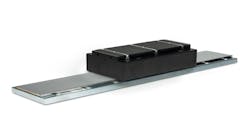Patrick Wheeler is controls product manager at Aerotech.
Tell us about your company’s state-of-the-art motor or drive?
Patrick Wheeler, controls product manager, Aerotech: Aerotech’s Automation1-XC2e is a compact, panel-mount, pulse-width modulation (PWM) servo motor drive. The innovative amplifier design and high-speed control circuits make this our highest-performing single-axis PWM servo motor drive, able to achieve in-position stability on precision mechanical stages at as low as 0.20 nm (rms). It also comes packed with standard features like safe torque off (STO) and an onboard memory of more than 67 Mb, which is helpful in many high-throughput applications. The functionality can be expanded to include analog and digital input/output (I/O), process tool control synchronized to actual position and feedback resolution multiplication.
What have been the biggest improvements to motor and drives in the past five years?
Patrick Wheeler, controls product manager, Aerotech: The biggest improvement has been getting higher-performance PWM-controlled power amplifier circuits. Many servo motor drive companies have been re-evaluating their control schemes and pushing the limits on what they can get out of PWM technology, which was once thought to be inferior to linear amplifier technology.
What’s the most innovative or efficient motor/drive application you’ve ever seen or been involved with?
Patrick Wheeler, controls product manager, Aerotech: At Aerotech, we typically align innovation with performance; when we hear motor/drive applications, we go right to precision motion control. So, for us, innovation always involves introducing a new method, idea or solution in motion control. Stages integrate rotary and linear motor technology, using up to four linear motor forcers as the powered stator. They’re modified to follow the contour of a rotary motor rotor and controlled by a single servo motor drive, so their placement relative to each other must be controlled with a high level of precision to avoid potential motor heating caused by the forcers fighting each other. On the larger stages, special rotor design considerations are required. These add to the design’s complexity because they demand a motor that can control stage accuracy to +/- 2 arcsec and output up to 1110.7 N*m of force, similar to the force of a Chevrolet Silverado 3500 Duramax pickup truck.
How have motors and drives benefitted from remote monitoring and connectivity?
Patrick Wheeler, controls product manager, Aerotech: Remote monitoring is a major benefit for end users, and it’s something we’ve been providing customers with for decades. Drives run side-by-side with and continuously stream data to a full motion controller. This data is then made available to users through the controller’s APIs, giving them the benefit of condition monitoring, overall equipment effectiveness (OEE) tracking and machine-to-machine performance comparison. Users can really get a good understanding of how well their systems are performing and be notified immediately of any issues.
Can you explain how software development has changed motor and drive design and production?
Patrick Wheeler, controls product manager, Aerotech: When it comes to motor and drive design, design and simulation software is making a big impact on design process decisions. Instead of guessing at how a motor will perform, we can run simulations and then make motor and drive design choices accordingly. When the real world more consistently matches the simulated environment, fewer design iterations are required and time to market is exponentially reduced.
How do motors and drives figure into digital-twin platform models being used by manufacturers?
Patrick Wheeler, controls product manager, Aerotech: Motors and drives are at the heart of digital twin platforms because they define the motion executed by automated systems. For example, an industrial robot may have a well-specified model that is very accurately represented in the digital twin model. However, the pose of that robot is defined by the motors driving its motion. If the motor's performance is affected by heating issues, then the actual pose will not match the simulated one. Fortunately, temperature sensors can be used with motors, and the motors’ thermal models can be integrated into the digital twin. Knowing how the motor reacts to heating in the digital twin can give users an even better idea of real-world conditions than the encoder feedback device could alone.
When will motors and drives become IT-friendly enough that engineers are no longer required for installation and operation?
Patrick Wheeler, controls product manager, Aerotech: That just depends on the application. For simple applications, when motors are enabled with plug-and-play capabilities, setting up drives and motors in a production environment is straightforward. With many modern motion control solutions, even basic to somewhat advanced tuning can be executed automatically on servo motor systems. For more complex systems, there isn’t yet an automated system that takes the engineer completely out of the loop.
What future innovations will impact the use of motors and drives in discrete-manufacturing operations?
Patrick Wheeler, controls product manager, Aerotech: There is really no limit on the number of applications for drives and motor systems. Even manufacturing processes that are still trusted to human hands are assisted with technologies such as wearable exoskeleton robotic suits. These suits keep the human in control while reducing the overall stress put on their bodies by repetitive motion.
Also read: Ease of use dominates motor and drive trends






